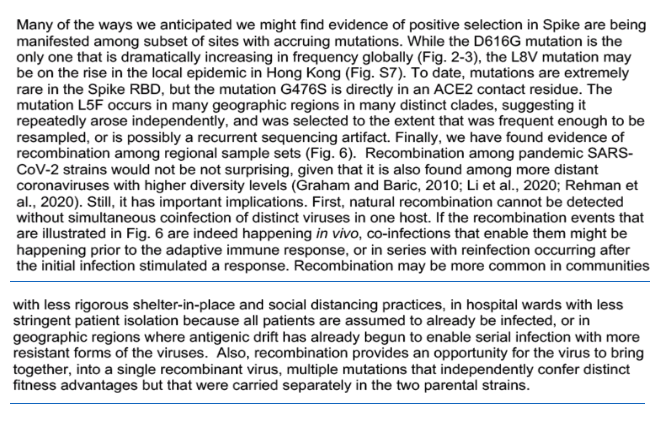| |
SARS-CoV-2 Mutant Took Over as Pandemic
Erupted-Probably Giving Virus Advantages
|
| |
| |
Mark Mascolini
A mutation in the spike protein of SARS-CoV-2, the virus that causes COVID-19, appeared when the coronavirus entered Europe and the United States and may make the virus easier to transmit [1]. SARS-CoV-2 bearing this mutation in the viral spike, which snares target cells, swiftly replaced the original Wuhan form of the virus wherever the mutant appeared.
These findings emerged from a genetic analysis of SARS-CoV-2 by researchers at Los Alamos National Laboratory and other centers, who express "urgent concern" about the spike mutation labeled D614G. If these results are verified, they could have grave implications for vaccine research. The report appears as a bioRxiv preprint that has not had peer review.
The Los Alamos team, led by Bette Korber, analyzed mutations in the SARS-CoV-2 spike in more than 6000 worldwide viral strains in a database called GISAID (Global Initiative for Sharing All Influenza Data), which "provides an opportunity to look more deeply into the evolutionary relationships among the SARS-CoV-2 sequences in the context of time and geography" [1]. The D614G spike mutation started spreading in Europe in early February 2020, jumped to the US East Coast and Canada in early March, and became the dominant global form in mid-March.
The scientists suggest 3 reasons why SARS-CoV-2 bearing the D614G spike mutation became the dominant form so fast. First, because D614 nestles in the antibody-dependent enhancement (ADE) region of the virus, it may facilitate antibody-dependent enhancement of viral activity. Second, the D614G mutation may destabilize certain essential interactions in SARS-CoV-2, and this may boost viral infectivity and thus encourage faster spread. Also, the mutation may confer resistance to protective D614-directed antibody responses in infected people, "making them more susceptible to reinfection with the newer G614 form of the virus."
As the Los Angeles Times reported, scientists initially observed that coronaviruses do not mutate as readily as influenza viruses, which require a new vaccine every year because of this constant shape shifting [2]. But the new findings "could upend that assumption" by suggesting the coronavirus SARS-CoV-2 can mutate readily to press its advantage against the human host. The Los Alamos discovery may also have unhappy implications for development of antibody-based therapies based on the original form of the virus.
If the COVID-19 pandemic fails to wane in warmer weather, as flu pandemics typically do, the Los Alamos team warns "this could exacerbate the potential for antigenic drift and the accumulation of immunologically relevant mutations in the population during the year or more it will take to deliver the first vaccine." Steadily tracking SARS-CoV-2 mutations now, they add, may help researchers "avert missing important evolutionary transitions in the virus that if ignored could ultimately limit the effectiveness of the first vaccines to clinical use."
Reference
1. Korber B, Fischer WM, Gnanakaran S, et al. Spike mutation pipeline reveals the emergence of a more transmissible form of SARS-CoV-2. bioRxiv. doi: https://doi.org/10.1101/2020.04.29.069054 (This report appears as a bioRxiv preprint that has not had peer review.)
2. Vartabedian R. Scientists say a now-dominant strain of the coronavirus could be more contagious than original. Los Angeles Times. May 5, 2020. https://www.latimes.com/california/story/2020-05-05/mutant-coronavirus-has-emerged-more-contagious-than-original

|
|
| |
| |
|
|
|